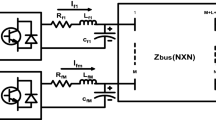Abstract
In a three-phase inverter, if the electricity consumers’ loads are not equal, balance will be disturbed and switching will be challenged. To overcome this problem, herein, a fuzzy sliding mode control is proposed to control the output voltages of a three-phase inverter. Control methods for commanding IGBTs have advantages over methods such as PWM and SVM as the effect of errors and uncertainties is neutralized by measuring the output error. Sliding mode control has long been used to control systems with uncertainty in modeling. This controller is robust because they provide sliding conditions by generating discontinuous control signals around the sliding surface. Despite these advantages, sliding mode control has its drawbacks. A popular method to solve these problems is fuzzy control, which promotes controller performance. In addition to paying attention to reducing the output error in inverters, changes in the state of switches should also be considered. In practice, the power loss increases and the inverter efficiency decreases, with increasing the disconnection and reconnection of IGBTs. In the present study, a multi-objective genetic algorithm is used so as to select the optimal control coefficients, in such a way that a compromise is made between the error and the number of times the keys are connected and disconnected.























Similar content being viewed by others
Data availability
All data are available.
References
Lee SS-S, Heng Y-E (2016) Improved single-phase split-source inverter with hybrid quasi-sinusoidal and constant PWM. IEEE Trans Indus Electron 64(3):2024–2031
Nguyen M-KH, Tran T-T, Lim Y-C (2018) A family of PWM control strategies for single-phase quasi-switched-boost inverter. IEEE Trans Indus Electron 34(2):1458–1469
Ghamari S-M, Mollaee H, Khavari F (2020) Design of robust self-tuning regulator adaptive controller on single-phase full-bridge inverter. IET Power Electron 13(16):3613–3626
Ng KC, Li Y (1994) Design of sophisticated fuzzy logic controllers using genetic algorithms. In: Proceedings of 1994 IEEE 3rd international fuzzy systems conference, pp. 1708–1712
Wen S, Chen MZQ, Zeng Z, Yu X (2016) Fuzzy control for uncertain vehicle active suspension systems via dynamic sliding-mode approach. IEEE Trans Syst, Man, Cybern Syst 47(1):24–32
Yorgancıoglu F, Kömürcügil H (2008) Single-input fuzzy-like moving sliding surface approach to the sliding mode control. Electr Eng 90(3):199–207
Go SJ, Lee MC, Park MK 2001 Fuzzy-sliding mode control of automatic polishing robot system with the self-tuning fuzzy inference based on genetic algorithm. In: Proceedings 2001 ICRA IEEE international conference on robotics and automation vol. 3 pp. 2962–2967
Lee WM, Huang HP (1996) Stabilization of nonholonomic mobile robots by a GA-based fuzzy sliding mode control,” Soft Computing in Intelligent Systems and Information Processing. In: Proceedings of the 1996 Asian fuzzy systems symposium. IEEE. pp. 388–393
Rezapour J, Sharifi M, Nariman-zadeh N (2011) Application of fuzzy sliding mode control to robotic manipulator using multi-objective genetic algorithm. In: 2011 international symposium on innovations in intelligent systems and applications. pp. 455–459
Kukrer O, Komurcugil H, Doganalp A (2006) Sliding mode control of single-phase UPS inverters using a three-level hysteresis switching function. In: IECON 2006–32nd annual conference on IEEE industrial electronics., pp. 331–335
Kömürcügil H (2012) Rotating-sliding-line-based sliding-mode control for single-phase UPS inverters. IEEE Trans Industr Electron 59(10):3719–3726
Cortajarena J-A, Barambones O, Alkorta P, Marcos J-D (2017) Sliding mode control of grid-tied single-phase inverter in a photovoltaic MPPT application. Sol Energy 155:793–804
Kumar K-V, Michael P-A, John J-P, Kumar S-S (2010) Simulation and comparison of SPWM and SVPWM control for three phase inverter. ARPN J Eng Appl Sci 5(7):61–74
Kim S-Y, Song S-G, Park S-J (2020) Minimum loss discontinuous pulse-width modulation per phase method for three-phase four-leg inverter. IEEE Access 8:122923–122936
Ayoubi E, Miveh M-R, Ghadimi A-A, Bagheri S (2020) Simultaneous voltage unbalance compensation and neutral-to-ground voltage minimization for an islanded mini-grid using model predictive control. Energy Sci Eng 10(9):3301–3316
Schwarzer U, De Doncker RW (2001) Power losses of IGBTs in an inverter prototype for high frequency inductive heating applications. In: IECON'01. 27th annual conference of the ieee industrial electronics society., Vol. 2, no. 37243, pp. 793–798
Lee S-S, Heng Y-E (2016) Improved single-phase split-source inverter with hybrid quasi-sinusoidal and constant PWM. IEEE Trans Industr Electron 64(3):2024–2031
Liu Z, Liu J, Li J (2012) Modeling, analysis, and mitigation of load neutral point voltage for three-phase four-leg inverter. IEEE Trans Industr Electron 60(5):2010–2021
Funding
The authors have not received any funding from any organization.
Author information
Authors and Affiliations
Corresponding author
Ethics declarations
Conflict of interest
The authors declare that they have no conflict of interest.
Rights and permissions
Springer Nature or its licensor (e.g. a society or other partner) holds exclusive rights to this article under a publishing agreement with the author(s) or other rightsholder(s); author self-archiving of the accepted manuscript version of this article is solely governed by the terms of such publishing agreement and applicable law.
About this article
Cite this article
Taran, B., Mohajeri, H. Designing a fuzzy sliding mode controller for a three-phase inverter via genetic algorithm. Int. J. Dynam. Control 11, 2452–2465 (2023). https://doi.org/10.1007/s40435-023-01143-3
Received:
Revised:
Accepted:
Published:
Issue Date:
DOI: https://doi.org/10.1007/s40435-023-01143-3




